Items filtered by date: September 2025
Treatment Options for Corns on the Feet
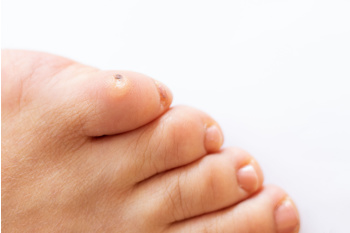
Corns develop on the feet when constant friction or pressure causes layers of skin to thicken on the tops of toes, between toes, or on bony areas. Corns can become painful, making it difficult to walk or wear shoes comfortably. In some cases a corn may become infected if not properly managed. A podiatrist can determine whether the corn is hard or soft in order to provide the best path to relieve discomfort. Treatment may include trimming away hardened skin in a sterile setting to reduce pressure, recommending shoe modifications to decrease rubbing, or prescribing custom orthotics to improve foot alignment and lower stress on affected areas. If a bone deformity, such as a hammertoe, continues to create pressure, surgery may be considered to correct the underlying problem and prevent recurrence. Professional care is important, as attempting to trim corns at home can lead to further injury. If you have a painful corn on your foot, it is suggested that you make an appointment with a podiatrist for an exam, diagnosis, and safe treatment.
Corns can make walking very painful and should be treated immediately. If you have questions regarding your feet and ankles, contact Donovan Gowdie, DPM of The Foot & Ankle Treatment Center. Our doctor will treat your foot and ankle needs.
Corns: What Are They? And How Do You Get Rid of Them?
Corns are thickened areas on the skin that can become painful. They are caused by excessive pressure and friction on the skin. Corns press into the deeper layers of the skin and are usually round in shape.
Ways to Prevent Corns
There are many ways to get rid of painful corns such as:
- Wearing properly fitting shoes that have been measured by a professional
- Wearing shoes that are not sharply pointed or have high heels
- Wearing only shoes that offer support
Treating Corns
Although most corns slowly disappear when the friction or pressure stops, this isn’t always the case. Consult with your podiatrist to determine the best treatment option for your case of corns.
If you have any questions, please feel free to contact our office located in Watkinsville, GA . We offer the newest diagnostic and treatment technologies for all your foot care needs.
What Are the Symptoms of PAD?
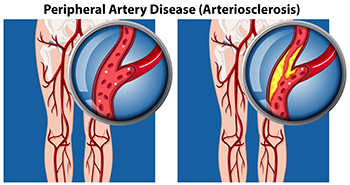 The condition that is referred to as peripheral artery disease (PAD) can cause poor circulation of the feet and various organs in the body. Common symptoms many patients experience can include numbing sensations in the feet, a loss of hair on the legs, and difficulty walking. It can occur as a result of arteries in the body that become narrow, which can gradually close. This can prevent necessary blood flow, and the feet may feel cold and turn blue. There are methods that can be implemented that may help to prevent PAD. These can include not smoking, incorporating a gentle exercise program into your daily routine, in addition to eating foods that are healthy. There may be existing medical conditions that can lead to PAD, including diabetes, obesity, or kidney disease. If you are experiencing numbing or tingling sensations in your feet, it is strongly suggested that you consult with a podiatrist who can properly diagnose and treat PAD.
The condition that is referred to as peripheral artery disease (PAD) can cause poor circulation of the feet and various organs in the body. Common symptoms many patients experience can include numbing sensations in the feet, a loss of hair on the legs, and difficulty walking. It can occur as a result of arteries in the body that become narrow, which can gradually close. This can prevent necessary blood flow, and the feet may feel cold and turn blue. There are methods that can be implemented that may help to prevent PAD. These can include not smoking, incorporating a gentle exercise program into your daily routine, in addition to eating foods that are healthy. There may be existing medical conditions that can lead to PAD, including diabetes, obesity, or kidney disease. If you are experiencing numbing or tingling sensations in your feet, it is strongly suggested that you consult with a podiatrist who can properly diagnose and treat PAD.
Peripheral artery disease can pose a serious risk to your health. It can increase the risk of stroke and heart attack. If you have symptoms of peripheral artery disease, consult with Donovan Gowdie, DPM from The Foot & Ankle Treatment Center. Our doctor will assess your condition and provide you with quality foot and ankle treatment.
Peripheral artery disease (PAD) is when arteries are constricted due to plaque (fatty deposits) build-up. This results in less blood flow to the legs and other extremities. The main cause of PAD is atherosclerosis, in which plaque builds up in the arteries.
Symptoms
Symptoms of PAD include:
- Claudication (leg pain from walking)
- Numbness in legs
- Decrease in growth of leg hair and toenails
- Paleness of the skin
- Erectile dysfunction
- Sores and wounds on legs and feet that won’t heal
- Coldness in one leg
It is important to note that a majority of individuals never show any symptoms of PAD.
Diagnosis
While PAD occurs in the legs and arteries, Podiatrists can diagnose PAD. Podiatrists utilize a test called an ankle-brachial index (ABI). An ABI test compares blood pressure in your arm to you ankle to see if any abnormality occurs. Ultrasound and imaging devices may also be used.
Treatment
Fortunately, lifestyle changes such as maintaining a healthy diet, exercising, managing cholesterol and blood sugar levels, and quitting smoking, can all treat PAD. Medications that prevent clots from occurring can be prescribed. Finally, in some cases, surgery may be recommended.
If you have any questions, please feel free to contact our office located in Watkinsville, GA . We offer the newest diagnostic and treatment technologies for all your foot care needs.
Tarsal Tunnel Syndrome and Relief From a Podiatrist
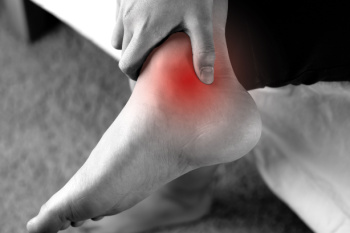
Tarsal tunnel syndrome is caused by compression of the posterior tibial nerve as it travels through the tarsal tunnel in the ankle. This pressure can result in pain, tingling, burning, or numbness in the foot and ankle. Causes include injury, flat feet, swelling, or conditions like arthritis. Risk factors may involve repetitive stress, obesity, or chronic inflammation. Symptoms can worsen with activity and may radiate into the toes. A podiatrist can diagnose the condition through examination and imaging, then create a personalized treatment plan that may include orthotics, or minimally invasive procedures. If you have persistent foot or ankle discomfort, it is suggested that you schedule a visit with a podiatrist who can provide an accurate diagnosis and treatment.
Tarsal tunnel syndrome can be very uncomfortable to live with. If you are experiencing tarsal tunnel syndrome, contact Donovan Gowdie, DPM of The Foot & Ankle Treatment Center. Our doctor can provide the care you need to keep you pain-free and on your feet.
Tarsal Tunnel Syndrome
Tarsal tunnel syndrome, which can also be called tibial nerve dysfunction, is an uncommon condition of misfiring peripheral nerves in the foot. The tibial nerve is the peripheral nerve in the leg responsible for sensation and movement of the foot and calf muscles. In tarsal tunnel syndrome, the tibial nerve is damaged, causing problems with movement and feeling in the foot of the affected leg.
Common Cause of Tarsal Tunnel Syndrome
- Involves pressure or an injury, direct pressure on the tibial nerve for an extended period of time, sometimes caused by other body structures close by or near the knee.
- Diseases that damage nerves, including diabetes, may cause tarsal tunnel syndrome.
- At times, tarsal tunnel syndrome can appear without an obvious cause in some cases.
The Effects of Tarsal Tunnel Syndrome
- Different sensations, an afflicted person may experience pain, tingling, burning or other unusual sensations in the foot of the affected leg.
- The foot muscles, toes and ankle become weaker, and curling your toes or flexing your foot can become difficult.
- If condition worsens, infections and ulcers may develop on the foot that is experiencing the syndrome.
A physical exam of the leg can help identify the presence of tarsal tunnel syndrome. Medical tests, such as a nerve biopsy, are also used to diagnose the condition. Patients may receive physical therapy and prescriptive medication. In extreme cases, some may require surgery.
If you have any questions please contact our office located in Watkinsville, GA . We offer the newest diagnostic and treatment technologies for all your foot and ankle needs.
Flip-Flops Versus Slides and What You Need to Know for Foot Health
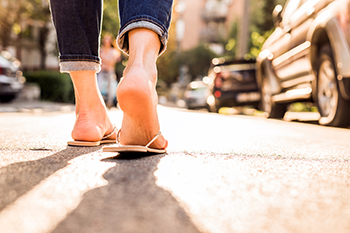
Flip-flops are a popular choice for warm weather due to their ease of wear and variety of designs and colors. Compared to slides, flip-flops often provide less stability and support, which can make them more uncomfortable for prolonged use. While slides offer slightly better coverage and support, both types of footwear can contribute to foot problems when worn frequently. Common drawbacks of flip-flops include lack of proper arch support, minimal cushioning, and increased risk of blisters, heel pain, or plantar fasciitis. A podiatrist can evaluate your footwear habits, recommend supportive alternatives, and provide treatments to address foot pain or prevent long-term issues. If you are experiencing discomfort from wearing flip-flops or slides, or have developed foot pain, it is suggested that you consult a podiatrist who can treat various foot conditions, and guide you on similar and appropriate shoes to wear.
Flip-flops are not always the best choice of footwear. If you have any concerns about your feet or ankles, contact Donovan Gowdie, DPM from The Foot & Ankle Treatment Center. Our doctor will assist you with all of your foot and ankle needs.
Flip-Flops and Feet
When the weather starts warming up, people enjoy wearing flip-flops. Flip-flops are comfortable, stylish, and easy to slip on and off; they're perfect for any summer beach goer. However, these shoes can cause harm to the feet.
How Can Flip-Flops Affect Me Long-Term?
- Ankle problems
- Hip problems
- Lower back problems
- Pain in the balls of the feet
- Problems with foot arches
- Changes in the way you walk
Are There Injuries Associated with Flip-Flops?
Yes. Since flip-flops are relatively weak and do not provide the same amount of support as sneakers, people who wear flip-flops regularly are more susceptible to injuries. On top of that, the open nature of the shoe makes your feet more prone to other problems, such as cuts and even infections. Common injuries and ailments include:
- Sprained ankles
- Blisters
- Infections
- Cuts and Scrapes
I like Wearing Flip-Flops. Are There Safe Alternatives?
When buying flip-flops, try to find ones that have sturdy soles and that are made of high-quality materials that will support for your feet. These flip-flops will cost more but will also last longer as a result.
If you have any questions, please feel free to contact our office located in Watkinsville, GA . We offer the newest diagnostic and treatment technologies for all your foot care needs.
Reminder: When Was the Last Time...?
Understanding Athlete’s Foot and Relief Tips
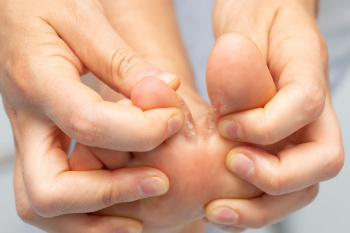
Athlete’s foot is a fungal infection that affects the skin of the feet, often developing between the toes. It thrives in warm and moist environments, making locker rooms, around pools, and tight footwear common sources of exposure. Symptoms include itching, burning, redness, peeling skin, and sometimes blisters or cracked areas that can become painful. Risk factors include excessive sweating, walking barefoot in public places, or wearing shoes that do not allow the feet to breathe. A podiatrist can diagnose the condition, provide effective anti-fungal treatments, and recommend prevention strategies to keep feet healthy. If you are experiencing signs of athlete’s foot, it is suggested that you consult a podiatrist who can provide effective treatment solutions, which may include prescribed medication.
Athlete’s Foot
Athlete’s foot is often an uncomfortable condition to experience. Thankfully, podiatrists specialize in treating athlete’s foot and offer the best treatment options. If you have any questions about athlete’s foot, consult with Donovan Gowdie, DPM from The Foot & Ankle Treatment Center. Our doctor will assess your condition and provide you with quality treatment.
What Is Athlete’s Foot?
Tinea pedis, more commonly known as athlete’s foot, is a non-serious and common fungal infection of the foot. Athlete’s foot is contagious and can be contracted by touching someone who has it or infected surfaces. The most common places contaminated by it are public showers, locker rooms, and swimming pools. Once contracted, it grows on feet that are left inside moist, dark, and warm shoes and socks.
Prevention
The most effective ways to prevent athlete’s foot include:
- Thoroughly washing and drying feet
- Avoid going barefoot in locker rooms and public showers
- Using shower shoes in public showers
- Wearing socks that allow the feet to breathe
- Changing socks and shoes frequently if you sweat a lot
Symptoms
Athlete’s foot initially occurs as a rash between the toes. However, if left undiagnosed, it can spread to the sides and bottom of the feet, toenails, and if touched by hand, the hands themselves. Symptoms include:
- Redness
- Burning
- Itching
- Scaly and peeling skin
Diagnosis and Treatment
Diagnosis is quick and easy. Skin samples will be taken and either viewed under a microscope or sent to a lab for testing. Sometimes, a podiatrist can diagnose it based on simply looking at it. Once confirmed, treatment options include oral and topical antifungal medications.
If you have any questions, please feel free to contact our office located in Watkinsville, GA . We offer the newest diagnostic and treatment technologies for all your foot care needs.

